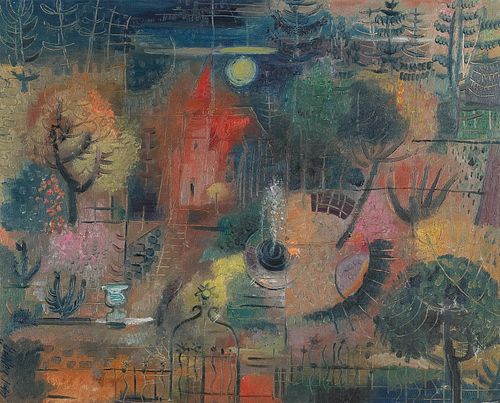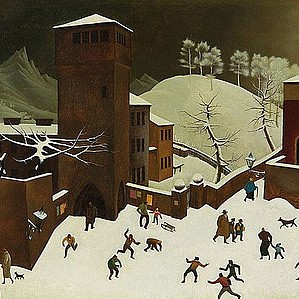ALFRED EICHHORN (St. Valentin 1909 - 1972 Donnerskirchen), Vespertine Garden, 1942
Lot 145
Estimate:
EUR€2,000 - EUR€5,000
$2,105.26 - $5,263.16
Absentee vs Live bid
Two ways to bid:
- Leave a max absentee bid and the platform will bid on your behalf up to your maximum bid during the live auction.
- Bid live during the auction and your bids will be submitted real-time to the auctioneer.
Bid Increments
| Price | Bid Increment |
|---|---|
| EUR€0 | EUR€10 |
| EUR€100 | EUR€50 |
| EUR€700 | EUR€100 |
| EUR€1,000 | EUR€200 |
| EUR€3,000 | EUR€300 |
| EUR€3,600 | EUR€400 |
| EUR€4,000 | EUR€500 |
| EUR€7,000 | EUR€1,000 |
| EUR€16,000 | EUR€2,000 |
| EUR€30,000 | EUR€3,000 |
| EUR€36,000 | EUR€4,000 |
| EUR€40,000 | EUR€5,000 |
About Auction
By Widder Auctions
May 19, 2022
Set Reminder
2022-05-19 11:00:00
2022-05-19 11:00:00
America/New_York
Bidsquare
Bidsquare : Masterpieces
https://www.bidsquare.com/auctions/widder-auctions/masterpieces-9287
Masterpieces of classical modernism by Austrian and international artists coming up for auction in Vienna on May 19th Widder Auctions office@widderauktionen.com
Masterpieces of classical modernism by Austrian and international artists coming up for auction in Vienna on May 19th Widder Auctions office@widderauktionen.com
- Lot Description
ALFRED EICHHORN*
(St. Valentin 1909 - 1972 Donnerskirchen),
Vespertine Garden, 1942
oil/fiber board, 62,5 x 77 cm
signed Alfred Eichhorn and dated 42
verso titled and inscribed Abendlicher Garten, Öl Alfred Eichhorn Stuttgart Gerokstr. 15, Leihgabe an Irene Bautlin von Otto Baum
Provenance: private property Vienna
ESTIMATE °€ 2.000 - 5.000
Austrian artist of the 20th century. Representative of non-objective and abstract art. Studied with Berthold Löffler and Anton Faistauer. Went to Berlin in 1932 and 1944 to Stuttgart. Close friendship with Willi Baumeister. From 1956 he lived and worked in Munich. Member of the group ZEN 49, as were Willi Baumeister, Rolf Cavael, Gerhard Fietz, Rupprecht Geiger, Willy Hempel, Brigitte Matschinsky-Denninghoff, and Fritz Winter. Together with Willi Baumeister he founded the Eidos-Presse for the publication of graphic portfolios. Created mainly figures, still lifes and landscapes.
The art of the painter and graphic artist Alfred Eichhorn can be located at the stylistic crossroads between representationalism and abstraction. He was born in Lower Austria and went to Berlin in 1932 after studying under Berthold Löffler and Anton Faistauer and subsequently built his career in Germany. His artistic work took a decisive turn in 1944 when he met the Stuttgart painter, graphic artist, stage designer, typographer and art theorist Willi Baumeister. Today he is regarded as an important German modernist artist, who, particularly under the impression of African art and culture, was inspired in his own abstract paintings by the stimulating power, the ornamental structures and colour tones. Before they got to know each other, Eichhorn's painting of the "Evening Garden" from 1942 reveals his involvement with the painting of primitive peoples and with the repertoire of folk-art forms. Although Eichhorn works with motifs from the tradition of European garden depictions with the wrought-iron garden fence with a gate, the fountain and the garden vases, trees, hedges and bushes - he does not commit himself to any spatial or two-dimensional form of depiction. Even in the colouring, which is characterized by dark olive-green tones and differently broken red tones, Eichhorn evades the obligation to perceive reality. Rather, Paul Klee becomes his model here, in whose imaginary landscapes it is not about the depiction of concrete places, but about the hotly contested concept of poetry at the time. Eichhorn's friend, Willi Baumeister, sought to address and define this in his writings on art theory. In his work "The Unknown in Art", published in 1947, he quotes the philosopher Leopold Ziegler, who explains the pair of terms 'mimetic' and 'poetic': "I mean the difference between a truly creative, in the Platonic term 'poetic' art, which finds expression in the geometric ideogram, in the mathematical symbols: and in an Aristotelian term 'mimetic' art, which strives for a graphic, pictorial, painterly representation of reality.” Like Klee and Baumeister, Eichhorn sees himself as a painting poet – in the sense of Baumeister, according to his analysis, the mimic (only) creates an afterimage, the poet, on the other hand, creates a role model. Eichhorn, who together with Baumeister became a member of the artists' group "ZEN 49" - the most important group of abstract art in Germany - founded the Eidos press together with Baumeister, which became known through the publication of original graphic portfolios. An inscription on the back shows that the picture was loaned to Irene Bautlin by the Swabian sculptor Otto Baum, who was ostracized by the Nazis.
PLEASE NOTE:
The purchase price consists of the highest bid plus the buyer's premium, sales tax and, if applicable, the fee of artists resale rights. In the case of normal taxation (marked ° in the catalog), a premium of 24% is added to the highest bid. The mandatory sales tax of 13% is added to the sum of the highest bid and the buyer's premium. The buyer's premium amounts to 28% in case of differential taxation. The sales tax is included in the differential taxation. - Shipping Info
-
Shipping
We will send you the invoice shortly after the auction. As soon as we have recieved the amount, the art can be picked up at Johannesgasse 9-13, 1010 Vienna. Please note that the buyer is responsible for pick-up and shipping of the lot.
Should you wish to ship your items, please contact: Mailboxes Email: oper@mbe-co.at Tel: 01 5128855
Please note that storage fees may apply, should the pieces not be picked up within 14 days after invoicing for domestic and 28 days for international transportation.
Our team will be happy to assist you with any further information at office@widderauktionen.com or at 0043 676 555 66 10.
-
- Buyer's Premium



 EUR
EUR CAD
CAD AUD
AUD GBP
GBP MXN
MXN HKD
HKD CNY
CNY MYR
MYR SEK
SEK SGD
SGD CHF
CHF THB
THB













